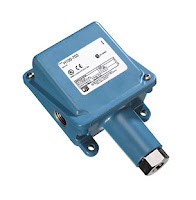The
normal status of a switch can be a confusing aspect of understanding the function of connected electrical and logic components in a process control application. The misunderstanding stems from the ambiguity of the word normal. Typically, electrical switch contacts are classified as being normally-open or normally-closed, referring to the open or closed status of the contacts under normal conditions. The key in understanding the normal state of a switch contact requires one to dissociate from their thinking, the concept or definition of normal used in everyday conversation. Where, among friends in casual conversation, the word normal tends to refer to what is expected, the normal status of the switch is, explicitly, its contacts electrical status when no stimulus is applied, that is, when the switch is at rest. An applied example of this definition is a momentary-contact pushbutton switch is not being pressed, because, when the pushbutton is not being pressed, the switch is experiencing no physical stimulation. Electrical schematic drawings always represent switches in their normal status. When an electrical switch on a lamp is in its normally-open state, the switch is open while receiving no physical stimulation.
The concept of normal is somewhat more complex when applied to
pressure and temperature switches. Pressure and temperature switches are actuated, not by electrical signal or human contact, but by process related stimuli, i.e. temperature, flow, pressure, or level. A flow switch is actuated by a defined amount of flow through a pipe. Lets say a flow switch is engineered to trigger an alarm when the flow rate inside a pipe is below a certain level. Even if the contacts of the flow switch are designated as being in their normally-closed status, the switch will be open when enough fluid is flowing through the pipe. The normal switch status (closed) indicates an abnormal process flow rate condition, because the switch is only going to be in its normal electrical status when the flow is low. Considering this inverse nature (normal switch status indicating abnormal process status), switch contacts are conventionally represented in accordance with the switch operation and not the process operation. The manufacturers of the pressure and temperature switches cannot predict the normal status of particular processes in which their switches will be used. By utilizing the conventional switch terminology, there is a common status designation for the normal status of the switch. The designation is applicable and readable regardless of the process conditions of the specific industry using the switch. This convention provides for universal comprehension of control system electrical schematics and other symbolic representations of control system operation.
 |
Pressure switch (courtesy of
United Electric Controls) |
In making the connection between the normal state of switch contacts and the normal state of a process, one should relate the switch state to the process condition which would serve as the stimulus to change the switch state. For a limit switch, which responds to physical contact by an object, normal means the target is not contacting the switch. For a proximity switch, normal means the target is far away. A normal pressure switch condition occurs when the pressure is low, or may even indicate a vacuum. Level switches are normal when the level is empty. Normal for a temperature switch means the temperature is low. Flow switches are normal when there is a low flow rate, or the fluid is stopped. Both an understanding of normal as defined by the manufacturer of the switch and normal in terms of industry specific processes is necessary to correctly interpret the status of an operation. Once the concept of normal used in everyday conversation is uncoupled from your process control thinking, things fall into place easily.


